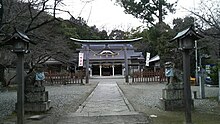Inbe Shrine
Inbe Shrine[a] is a Shinto shrine located in Tokushima, Japan.[1][2][3]
The shrine is linked to and named after the Inbe clan,[4] who used to rule the region.[5]: 384
It is on the slope of Mount Bizan, and some consider it the Ichinomiya or first-ranked shrine of Shikoku.[4] It is a Beppyo shrine, or a shrine that is particularly notable in a certain way with a significant history to it and a Myojin Taisha. It is linked to the Inbe clan, the first settlers of Eastern Shikoku.[4]
It is located on a hill called Seimi-Yama on the southern end of Tokushima. It is uphill from a Konpira Shrine called Seimi no Konpira.[6]
Their main family shrine is Awa Shrine.[7]
It enshrines Futodama,[8] the ancestor of the Inbe clan.[9][10]
It has a famous weaving hall where the cloth of imperial succession is woven.[11]
While not a part of the Shikoku Pilgrimage it is often attended by pilgrims on the pilgrimage due to proximity to the official 88 sites.[12]
History
The shrine is located near a very old Kofun. This one is in Naruto Itano Kofun Cluster and has some traits resembling Zenpokoenfun which raises speculation about their origins being nearby.[13]
The shrine is linked to and named after the Inbe clan,[4] who used to rule the region.[5]: 384
The clan started off as low class but gained power due to religious reasons.[14]
Hemp cloth has been used in Shinto for a long time. It is known for its association with purity. The Inbe clan traditionally served the role of providing hemp to the Imperial family.[15]: 657–659
According to the Kogo Shūi the Inbe clan were given Awa Province in Shikoku so they could cultivate hemp there.[5]: 384
Hironari of the Inbe clan wrote the "Kogoshui" in 807 CE. It mentions the Inbe clan's responsibility for sacred cloth. This began with the goddess Ama no Hiwashi. The Inbe clan produced cloth from mulberry and hemp. They grew these plants in Awa Province, now Tokushima prefecture.[15]: 657–659 They weave the cloth for the Daijosai at Inbe shrine.[16]
The Engishiki is an ancient Japanese text. It lists specific offerings for Shinto rituals. These include hemp and other bast fibers. Textiles made from these fibers were commonly given as offerings. There are two types of offering cloth. Aratae is a rough cloth. Nigitae is a smooth, finely woven fabric.[15]: 657–659
During the reign of Emperor Kōtoku, the Inbe, along with the Nakatomi and Urabe clans, were tasked with supervising Jingikan.[14] The clan lost its power during the reign of Emperor Shōmu.[17] In the year 927 CE, members of the clan lost their long-standing right to present asa cloth for use in the imperial rituals.[5]
Over time, the Inbe clan's role changed. By 927 AD, they lost the right to present hemp offerings. The last mulberry fiber aratae from the Inbe clan was in 1339. By the 20th century, the clan again produced hemp cloth for the Imperial Family.[15]: 657–659 The Miki family (三木) from the Inbe clan made this cloth for Emperor Hirohito in 1928 and Emperor Akihito in 1990.[15]: 657–659 [18][13] and Emperor Naruhito in 2019.[11] Inbe shrine is still used for the weaving today.[11]
The Dajiosai is a special version of Niinamesai that is celebrated on that year the Japanese Emperor is crowned[15]: 657–659 [19]
The taima ritual is held at Ise Shrine. It is performed five times a year. It honors Amaterasu, the goddess of hemp and rice. Taima amulets are distributed at this shrine. They are tied with hemp bark strips.[15]: 657–659
Architecture
It has a carving of a man fighting a dragon on its porch.[20]
See also
Notes
- ^ Also known as Inbe Jinja, Imbe Shrine, or Imbe Jinja
References
- ^ https://www.megalithic.co.uk/article.php?sid=24973
- ^ https://brill.com/previewpdf/book/9789004236332/B9789004236332-s014.xml
- ^ Murray (Firm), John; Chamberlain, Basil Hall (1913). A Handbook for Travellers in Japan Including the Whole Empire from Saghalien to Formosa. J. Murray.
- ^ a b c d "Shikoku Bilingual Guidebook".
- ^ a b c d Ab, Weiner (1991-04-17). CLOTH & HUMAN EXP PB. Smithsonian Institution. p. 386. ISBN 978-0-87474-995-3.
- ^ Chamberlain, Basil Hall; Mason, W. B. (1896). A Handbook for Travellers in Japan. J. Murray.
- ^ Carter, Caleb (2020), "Imagining an Ancient Tradition: Eighteenth-Century Narratives of Shugendō at Mount Togakushi", Defining Shugendō, Bloomsbury Academic, doi:10.5040/9781350179424.ch-003, ISBN 978-1-350-17939-4, S2CID 229615301, retrieved 2023-10-27
- ^ "Imbe-jinja Shrine | 備前ガイド".
- ^ "Ameno Futodama • A History of Japan - 日本歴史". A History of Japan - 日本歴史. Retrieved 2020-11-05.
- ^ "Encyclopedia of Shinto - Home : Kami in Classic Texts : Futodama". eos.kokugakuin.ac.jp. Retrieved 2021-07-13.
- ^ a b c NEWS, KYODO. "Hemp twine for key imperial succession rite handed to weavers". Kyodo News+. Retrieved 2023-11-20.
- ^ "The Shikoku Pilgrimage (四国遍路) : Day 7 (Day 8 rest day)". Wikiloc | Itinéraires et randonnées du monde (in French). Retrieved 2023-04-25.
- ^ a b Kawanishi, Kenshiro (2022-03-24). "Could a Secret Rite of Japanese Emperors have come from Eurasian Nomadic Tribes? | JAPAN Forward". japan-forward.com. Retrieved 2023-11-20.
- ^ a b "Imbe Clan • A History of Japan - 日本歴史". A History of Japan - 日本歴史. Retrieved 2021-09-20.
- ^ a b c d e f g Clarke, Robert C.; Merlin, Mark D. (2013-09-01). Cannabis: Evolution and Ethnobotany. Univ of California Press. ISBN 978-0-520-27048-0.
- ^ Tama, Pagan (2019-09-08). "Pagan & Shinto News: Catholic School Bans Harry Potter Books Over Fears Of 'Curses And Spells'". Pagan Tama. Retrieved 2023-04-25.
- ^ Brown, Delmer M.; Hall, John Whitney; McCullough, William H.; Jansen, Marius B.; Shively, Donald H.; Yamamura, Kozo; Duus, Peter (1988). The Cambridge History of Japan. Cambridge University Press. p. 518. ISBN 978-0-521-22352-2.
- ^ "Mikike house – MimaKankouBureau". en.mimakankou.or.jp. Retrieved 2023-11-20.
- ^ Yukihiro Enomoto. "Japan emperor performs centuries-old succession rite". Nikkei Asian Review. Archived from the original on 23 September 2020. Retrieved 24 September 2020.
- ^ https://forgottenbooks.com/it/download/AroundtheWorldThroughJapan_11368777.pdf


